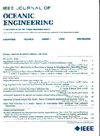A Gradient-Based Path Following Control Method for Underactuated Autonomous Marine Vehicle
IF 5.3
2区 工程技术
Q1 ENGINEERING, CIVIL
引用次数: 0
Abstract
Due to their underactuation, motion control for autonomous marine vehicles (AMVs) has always been a tricky problem. Most current path following control methods for underactuated autonomous marine vehicles apply geometric projection to map position error to yaw angle in order to decouple the yaw thrust moment in the controller design. However, there will be deviations in the geometric projection because of sideslip, especially when external disturbances exist. Moreover, the performance of the geometric projection method is greatly affected by the look-ahead distance. In this article, a novel path following control method for underactuated AMVs is proposed. This method directly takes the position of a point as the control object, with the process of geometric projection eliminated, thereby getting rid of the negative impact of sideslip. The desired path is modeled as a scalar field, and the commanded position is taken to lie along the direction of the gradient of this scalar field at the kinematics level. At the kinetics level, disturbance rejection capability is constructed by applying disturbance observers and compensating for the estimated disturbances in the control effort. It is proved that all signals in the closed-loop system are uniformly ultimately bounded. Simulation and experimental results demonstrate that the proposed method is effective.欠驱动自主船舶基于梯度的路径跟踪控制方法
由于其欠驱动性,自主船舶的运动控制一直是一个棘手的问题。目前针对欠驱动自主船舶的路径跟踪控制方法,大多采用几何投影将位置误差映射到偏航角,以解耦控制器设计中的偏航推力力矩。但是,由于侧滑,特别是在存在外界干扰的情况下,几何投影会产生偏差。此外,几何投影法的性能受前视距离的影响较大。本文提出了一种新的欠驱动amv路径跟踪控制方法。该方法直接以点的位置作为控制对象,省去了几何投影的过程,从而消除了侧滑的负面影响。将期望的路径建模为标量场,并在运动学水平上取指令位置沿该标量场的梯度方向。在动力学水平上,扰动抑制能力是通过应用扰动观测器和补偿控制努力中估计的扰动来构建的。证明了闭环系统中的所有信号都是一致最终有界的。仿真和实验结果表明了该方法的有效性。
本文章由计算机程序翻译,如有差异,请以英文原文为准。
求助全文
约1分钟内获得全文
求助全文
来源期刊

IEEE Journal of Oceanic Engineering
工程技术-工程:大洋
CiteScore
9.60
自引率
12.20%
发文量
86
审稿时长
12 months
期刊介绍:
The IEEE Journal of Oceanic Engineering (ISSN 0364-9059) is the online-only quarterly publication of the IEEE Oceanic Engineering Society (IEEE OES). The scope of the Journal is the field of interest of the IEEE OES, which encompasses all aspects of science, engineering, and technology that address research, development, and operations pertaining to all bodies of water. This includes the creation of new capabilities and technologies from concept design through prototypes, testing, and operational systems to sense, explore, understand, develop, use, and responsibly manage natural resources.
 求助内容:
求助内容: 应助结果提醒方式:
应助结果提醒方式:


